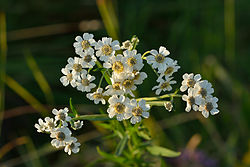| Sneezewort | |
|---|---|
 | |
| Scientific classification | |
| Kingdom: | Plantae |
| Clade: | Tracheophytes |
| Clade: | Angiosperms |
| Clade: | Eudicots |
| Clade: | Asterids |
| Order: | Asterales |
| Family: | Asteraceae |
| Genus: | Achillea |
| Species: | A. ptarmica |
| Binomial name | |
| Achillea ptarmica | |
| Synonyms [1] | |
Synonymy
| |
Achillea ptarmica is a Eurasian species of herbaceous perennial flowering plant in the genus Achillea . Common names include the sneezewort, sneezeweed, bastard pellitory, European pellitory, fair-maid-of-France, goose tongue, sneezewort yarrow, wild pellitory, and white tansy. [2]
